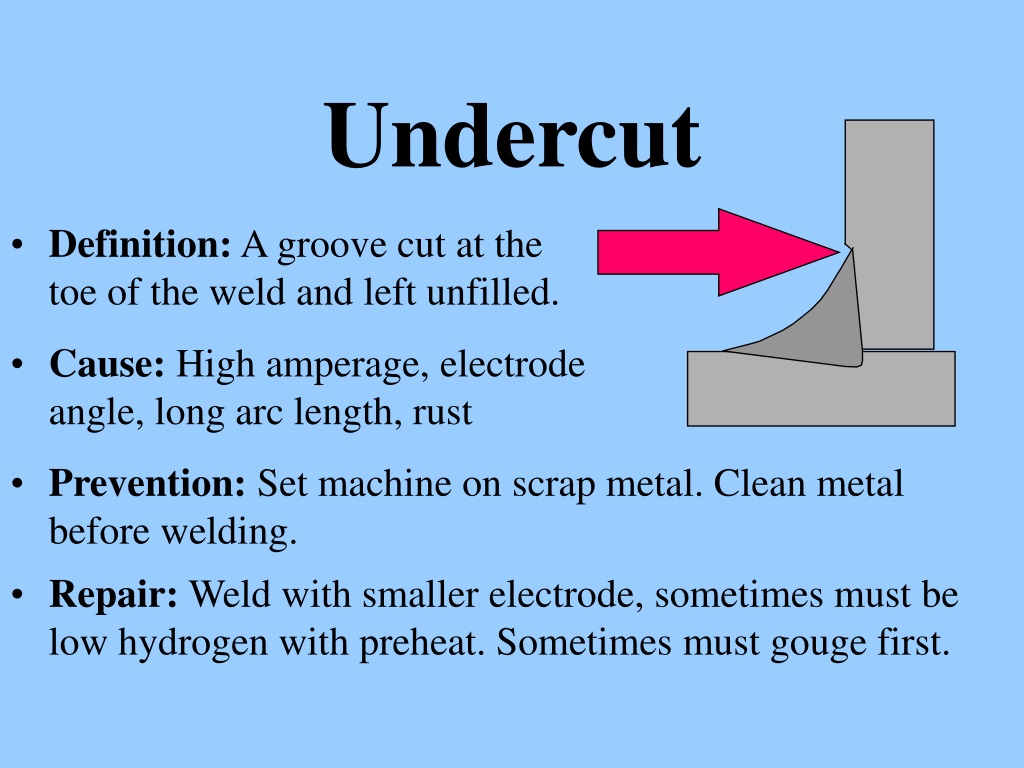Professional Techniques for Preventing Weld Undercut Efficiently
Mastering the Art of Welding: How to Avoid Undercut Welding Issues for Flawless Construction Outcomes
By comprehending the root triggers of undercut welding and applying effective techniques to prevent it, welders can boost their craft to new levels of excellence. In the quest of perfect construction results, grasping the art of welding to prevent undercut concerns is not simply an ability but a requirement for those aiming for excellence in their job.
Comprehending Undercut Welding

To prevent undercut welding, welders should make sure proper welding criteria, such as changing the current, voltage, travel rate, and maintaining the proper electrode angle. By recognizing the reasons of undercut welding and executing preventive actions, welders can accomplish high-quality, structurally audio welds.
Causes of Undercut in Welding
Understanding the factors that add to undercut in welding is necessary for welders to create premium, structurally sound welds. Damaging happens when the weld steel does not appropriately load the groove formed in between the base steel and the formerly deposited weld metal. Numerous elements can bring about undercut in welding. One typical reason is extreme warmth input. Welding at high temperatures for extended periods can lead to the base metal melting greater than wanted, causing undercut. Inadequate welding wrong or existing welding rate can likewise contribute to damage. Not enough current may not offer sufficient warmth to melt the base and filler metals properly, while extreme speed can avoid proper fusion, causing undercut. Furthermore, incorrect electrode angles or inaccurate torch adjustment strategies can develop areas of low weld metal deposition, promoting undercut. Understanding these reasons and executing proper welding methods can assist stop undercutting problems, guaranteeing strong and sturdy welds.
Techniques to avoid Undercutting

To minimize the risk of undercutting in welding, my blog welders can employ calculated welding strategies aimed at boosting the high quality and honesty of the weld joints. Additionally, utilizing the proper welding technique for the particular joint arrangement, such as weave or stringer beads, can contribute to decreasing undercutting.
Additionally, appropriate joint preparation, consisting of ensuring clean base materials cost-free of contaminants and making use of the appropriate welding have a peek at this website consumables, is important in preventing undercut defects. Employing back-step welding techniques and regulating the weld bead profile can likewise assist disperse warmth evenly and decrease the risk of undercut. Routine inspection of the weld joint during and after welding, as well as applying quality control procedures, can aid in finding and addressing damaging concerns immediately. By executing these methods faithfully, welders can achieve perfect fabrication results with minimal undercut defects.
Relevance of Proper Welding Parameters
Choosing and keeping proper welding criteria is crucial for achieving effective welds with minimal problems. Welding criteria refer to variables such as voltage, current, travel rate, electrode angle, and protecting gas circulation price that straight affect the welding process. These specifications must be carefully readjusted based on the type of material being bonded, its density, and the welding technique utilized.
Proper welding criteria guarantee the best amount of warm is related to thaw the base steels and Going Here filler product consistently. If the criteria are set too expensive, it can result in extreme heat input, triggering spatter, burn-through, or distortion. On the other hand, if the parameters are too reduced, insufficient fusion, absence of penetration, or damaging might happen.
Quality Guarantee in Welding Operations

Conclusion
To conclude, mastering the art of welding needs a comprehensive understanding of undercut welding, its reasons, and strategies to avoid it. By making certain appropriate welding specifications and executing quality control techniques, remarkable construction outcomes can be achieved. It is necessary for welders to continually aim for excellence in their welding operations to stay clear of undercut issues and produce high-grade welds.
Undercut welding, a common issue in welding processes, occurs when the weld steel doesn't appropriately fill up the groove and leaves a groove or depression along the bonded joint.To avoid undercut welding, welders ought to make certain correct welding parameters, such as readjusting the existing, voltage, traveling rate, and preserving the proper electrode angle. Poor welding incorrect or current welding rate can additionally add to undercut.To reduce the threat of damaging in welding, welders can employ tactical welding strategies aimed at improving the quality and honesty of the weld joints.In conclusion, mastering the art of welding calls for an extensive understanding of undercut welding, its causes, and strategies to avoid it.